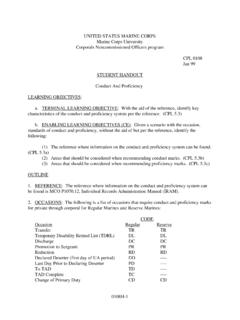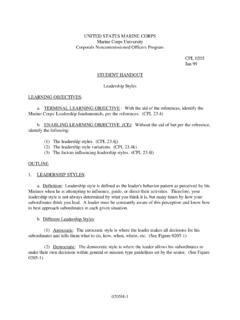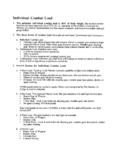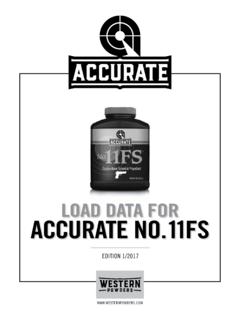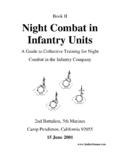Transcription of UNITED STATES MARINE CORPS - Militarytraining.net
1 UNITED STATES MARINE CORPS MARINE CORPS University Corporals Noncommisioned Officers Program CPL 0101 Aug 02 STUDENT HANDOUT Physical Conditioning Program LEARNING OBJECTIVES a. TERMINAL LEARNING OBJECTIVE: Given a group of marines in appropriate PT gear, a training site, and with the aid of references, lead a unit in physical fitness conditioning per the references. (CPL ) b. ENABLING LEARNING OBJECTIVES : Given a scenario on physical conditioning and without the aid of but per the references, identify the following: (1) MARINE CORPS Order on the Physical Conditioning Program. (CPL ) (2) Physical conditioning. (CPL ) (3) Principles of physical conditioning. (CPL ) (4) Components of physical (CPL ) (5) Types of physical conditioning programs. (CPL ) (6) FITT factors. (CPL ) (7) Specific physical conditioning programs.
2 (CPL ) (8) Climatic considerations. (CPL ) (9) Physiological differences between the sexes. (CPL ) (10) How age affects physical activity. (CPL ) (11) Nutrition guidelines. (CPL ) OUTLINE. 1. MARINE CORPS ORDER ON PHYSICAL CONDITIONING PROGRAM. a. SCOPE. Every MARINE must be physically fit, regardless of age, grade, or duty assignment. Fitness is essential to the day-to-day effectiveness and combat readiness of the MARINE CORPS . Furthermore, physical fitness is an indispensable aspect of leadership. The habits of self-discipline required to gain and maintain a high level of physical fitness are inherent to the MARINE CORPS way of life and must be a part of the character of every MARINE . marines who are not physically fit can be a detriment to the readiness and combat efficiency of their unit. Accordingly, every MARINE will engage in an effective PCP on a continuing and progressive basis.
3 B. The physical conditioning program requires each MARINE to receive a minimum of 3 hours physical fitness training per week, to be tested semiannually, and obtain a minimum standard of 0101H-1 third class. The attainment of a higher level score is encouraged since PFT scores are figured into composite scores; however, do not overemphasize PT to the point where it is detrimental to the development of the total MARINE . c. The order that provides physical fitness requirements for the MARINE CORPS is MCO , MARINE CORPS Physical Fitness Test and Body Composition Program Manual (MCPFTBCPM). 2. PHYSICAL CONDITIONING. The definition of physical fitness is subjective to those defining it. The MARINE CORPS considers physical fitness to be the ability of a MARINE to meet the physical demands of any combat or duty situation without undue fatigue. To achieve this state of physical fitness, physical conditioning should incorporate the components and principles.
4 3. PRINCIPLES OF PHYSICAL CONDITIONING. There are several different principles to consider when developing an effective PCP: a. Progression. Conditioning programs must incorporate a systematic means to increase training load. b. Regularity. To realize a conditioning effect, training programs must conduct physical conditioning sessions at least 3-5 times per week. c. Overload. Only when the various systems of the body are overloaded will they become able to handle greater load. d. Variety. Varying a program from time to time maintains interest and prevents staleness. e. Recovery. Essential for allowing the systems overloaded during conditioning to adapt and become stronger. f. Balance. Balanced conditioning programs ensure all the components of physical fitness conditioning (strength, endurance, and mobility) are properly addressed. g. Specificity. Conditioning that is specific in nature yields specific gains.
5 For example, stationary bike riding is of little value in improving running. 4. COMPONENTS OF PHYSICAL CONDITIONING. To capitalize on those components that can benefit conditioning efforts, the following categories of exercises should be included in both individual and unit PCPs: a. Strength. Muscular strength refers to the ability of the muscular system to move the body through resistance. Many associate strength training with progressive resistive exercises using weights and machines. However, the ability of a MARINE to effectively handle their own body weight should be a prerequisite before integrating strength training with machines into their program. Strength training can be broadly separated into two categories, general and specific. 0101H-2 (1) General Strength Training. This type of training strengthens the muscular system by focusing on a full body workout for strength and size.
6 In this type of training, the major muscle groups are exercised without a specific task or functional goal in mind. This type of strength training contributes to overall health. (2) Specific Strength Training. This type of strength training is task specific. For example, marines desiring to climb a rope better would do rope climb training wearing body armor, and focus their strength training on muscles involved in rope climbing. A company of marines expecting to operate in hilly terrain would focus their strength training primarily on lower body strength. b. Endurance. Two types of endurance conditioning are needed for a MARINE to meet the physical demands of combat, aerobic and anaerobic. (1) Aerobic Endurance. Aerobic activity, meaning in the presence of oxygen, is categorized by physical demands that are sub-maximal (not an all out effort) and involve activity that is continuous in nature (lasting more than 3-5 minutes).
7 Two examples are road marching and long distance running. (2) Anaerobic Endurance. Anaerobic activity, meaning without oxygen, is categorized by physical demands that are high intensity and of shorter (less than 2-3 minutes) duration. Examples are rope climbing, most forms of weight lifting, and running short, quick distances. c. Mobility. Mobility condition is geared towards improving quality of movement. Quality of movement depends on the following: (1) Posture (2) Balance and stability (3) Agility (4) Coordination (5) Power (6) Speed (7) Flexibility 5. TYPES OF PHYSICAL CONDITIONING PROGRAMS. a. Developmental Program. marines in a beginning or poor state of physical readiness need a program, which will develop strength, endurance, physical skills and character traits, which are beneficial to the successful accomplishment of MARINE CORPS , missions.
8 B. Maintenance Program. This program is designed to maintain an individual or unit at their current level of fitness. This is the most common type seen in the MARINE CORPS . c. Remedial Program. Remedial programs are for those who possess substandard physical fitness levels. Those who are overweight, fail to reach physical fitness test standards, or who have 0101H-3 missed extended periods of conditioning due to illness, injury, or other absence. Light or no duty marines should be included as much as their condition will allow. 6. FITT FACTORS AND HOW THEY RELATE TO PHYSICAL CONDITIONING. a. Frequency: This factor applies to how often you conduct PT. You get physically fit because your body sees a need to adapt itself to a different set of conditions, such as an increased demand on your heart or certain muscles. If this increased demand is only occasionally applied, then your body will not see a need to adapt.
9 By order, marines are required to participate in physical training at a minimum of 3 hours a week. This means that you will have three, one hour long, PT sessions per week. For optimal results, leaders should strive to conduct five, one hour long, PT session per week. b. Intensity: Training at the right intensity is the biggest problem in unit programs. The intensity should vary with the type of exercise being done. Exercise for (CR) cardio-respiratory development must be strenuous enough to elevate the heart rate to between 60-90 percent of the heart rate reserve. Appendix A contains a more detailed discussion of heart rate reserve and how to determine what yours is. Those with low fitness levels should start exercising at a lower training heart rate of about 60 percent of heart rate reserve. For muscular strength and endurance, intensity refers to the percentage of the maximum resistance that is used for a given exercise.
10 C. Time: Like intensity, the time spent exercising depends on the type of exercise being done. At least 20 to 30 continuous minutes of intense exercise must occur in order to improve any level of fitness. d. Type: Type refers to the kind of exercise performed. (1) CR training requires rhythmic and continuous use of large muscle groups. (2) Muscular training requires progressive work against resistance, to include - weights, machines, and natural body weight (sit-ups, pull-ups, and push-ups). (3) Flexibility exercises, for safety reasons, should be static (slow, gradual, and controlled) stretching. This type of stretching is least likely to cause injury and is preferred by professionals. 7. SPECIFIC PHYSICAL CONDITIONING PROGRAMS. a. Daily 16 Program. The Daily 16 Program is a comprehensive series of warmup, conditioning, and cool-down exercises replacing the former Daily 7 Program.

